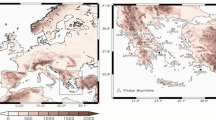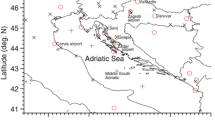Abstract
A continental scale evaluation of Antarctic surface winds is presented from global ERA-40 and ERA-Interim reanalyses and RACMO2/ANT regional climate model at 55 and 27 km horizontal resolution, based on a comparison with observational data from 115 automatic weather stations (AWS). The Antarctic surface wind climate can be classified based on the Weibull shape factor k w . Very high values (k w > 3) are found in the interior plateaus, typical of very uniform katabatic-dominated winds with high directional constancy. In the coast and all over the Antarctic Peninsula the shape factors are similar to the ones found in mid-latitudes (k w < 3) typical of synoptically dominated wind climates. The Weibull shape parameter is systematically overpredicted by ERA reanalyses. This is partly corrected by RACMO2/ANT simulations which introduce more wind speed variability in complex terrain areas. A significant improvement is observed in the performance of ERA-Interim over ERA-40, with an overall decrease of 14 % in normalized mean absolute error. In escarpment and coastal areas, where the terrain gets rugged and katabatic winds are further intensified in confluence zones, ERA-Interim bias can be as high as 10 m s−1. These large deviations are partly corrected by the regional climate model. Given that RACMO2/ANT is an independent simulation of the near-surface wind speed climate, as it is not driven by observations, it compares very well to the ERA-Interim and AWS-115 datasets.












Similar content being viewed by others
References
Arthern RJ, Winebrenner DP, Vaughan DG (2006) Antarctic snow accumulation mapped using polarization of 4.3-cm wavelength microwave emission. J Geophys Res 111:D06107. doi:10.1029/2004JD005667
Ball FK (1960) Winds on the ice slopes of Antarctica, Antarctic meteorology. Proceedings of the symposium in Melbourne, 1959, Pergamon, pp 9–16
Berrisford P, Dee D, Fielding K, Fuentes M, Kallberg P, Kobayashi S, Uppala S (2009) The ERA-interim archive, ERA Report Series, ECMWF, 16 pp
Bromwich DH et al. (1993) Spatial and temporal characteristics of the intense katabatic winds in Terra Nova Bay, Antarctica. In: Bromwich DH, Stearns CR (eds) Antarctic meteorology and climatology: studies based on automatic weather stations. Antarctic Research Series 61:47–68
Bromwich DH, Fogt RL (2004) Strong trends in the skill of the ERA-40 and NCEP-NCAR reanalysis in the high and midlatitudes of the Southern Hemisphere, 1958–2001. J Clim 17:4603–4619
Bromwich DH, Nicolas JP, Monaghan AJ (2011) An assessment of precipitation changes over Antarctica and the Southern Ocean since 1989 in contemporary global reanalyses. J Clim 24:4189–4209
Dee DP et al (2011) The ERA-Interim reanalysis: configuration and performance of the data assimilation system. Quart J R Meteorol Soc 137:553–597
Ettema et al (2010) Climate of the Greenland ice sheet using a high-resolution climate model—part 1: evaluation. Cryosphere 4:511–527
Gallée J, Schayes G (1994) Development of a three-dimensional Meso-γ primitive equation model: katabatic winds simulation in the area of Terra Nova Bay, Antarctica. Mon Wea Rev 122:671–685
King JC, Turner J (1997) Antarctic meteorology and climatology. Cambridge University Press, Cambridge
Lazzara MA, Weidner GA, Keller LM, Thom JE, Cassano JJ (2012) Antarctic automatic weather station program: 30 years of polar observations. Bull Am Meteorol Soc. doi:10.1175/BAMS-D-11-00015.1
Lenaerts JTM, van den Broeke MR, Déry SJ, van Meijgaard E, van de Berg J, Sanz Rodrigo J (2012) Regional climate modeling of snowdrift in Antarctica, Part 1: methods and model evaluation. J Geophys Res 117:1–17
Louis JF (1979) A parametric model of vertical eddy fluxes in the atmosphere. Boundary Layer Meteorol 17:187–202
Madsen H et al (2005) Standardizing the performance of short-term wind prediction models. Wind Eng 29:475–489
Munneke K et al (2011) A new albedo parameterization for use in climate models over the Antarctic ice sheet. J Geophys Res 116:D05114. doi:10.1029/2010JD015113
Parish TR, Bromwich DH (1987) The surface wind field over the antarctic ice sheets. Nature 328:51–54
Parish TR, Bromwich DH (2007) Reexamination of the near-surface airflow over the antarctic continent and implications on atmospheric circulations at high southern latitudes. Mon Wea Rev 135:1961–1973
Parish TR, Cassano JJ (2003) Diagnosis of the katabatic wind influence on the wintertime antarctic surface wind field from numerical simulations. Mon Wea Rev 131:1128–1139
Parish TR, Wendler G (1991) The katabatic wind regime at Adélie Land, Antarctica. Int J Climatol 11:97–107
Paristh TR, Walker R (2006) A re-examination of the winds of Adélie Land. Aust Met Mag 55:105–117
Pettré P, Renaud MF, Déqué M, Planton S, André JC (1990) Study of the influence of katabatic flows on the antarctic circulation using GCM simulations. Meteorol Atmos Phys 43:187–195
Reijmer CH, van Meijgaard E, van den Broeke MR (2004) Numerical studies with a regional atmospheric climate model based on changes in the roughness length for momentum and heat over Antarctica. Boundary Layer Meteorol 111:313–337
Sanz Rodrigo J (2011) On Antarctic Wind Engineering, Ph.D. Thesis, Univeristé Libre de Bruxelles and von Karman Institute for Fluid Dynamics, Belgium. http://theses.ulb.ac.be/ETD-db/collection/available/ULBetd-03152011-235458/
Stearns CR, Wendler G (1988) Research results from antarctic automatic weather stations. Rev Geophys 26:45–61
Stearns CR, Keller LM, Weidner GA, Sievers M (1993) Monthly mean climatic data for antarctic automatic weather stations. In: Bromwich DH, Stearns CR (eds) Antarctic meteorology and climatology: studies based on automatic weather stations. Antarctic Research Series 61:1–21
Turner J et al (2004) The SCAR READER project: toward a high-quality database of mean antarctic meteorological observations. J Clim 17:2890–2898
Uppala SM et al (2005) The ERA-40 re-analysis. Quart J R Meteorol Soc 131:2961–3012
Van de Berg WJ, van den Broeke MR, Reijmer CH, van Meijgaard E (2005) Characteristics of the antarctic surface mass balance 1958–2002 using a regional atmospheric climate model. Ann Glaciol 41:97–104
Van de Berg WJ, van den Broeke MR, van Meijgaard E (2008) Spatial structures in the heat budget of the Antarctic atmospheric boundary layer. The Cryosphere 2:1–12
van den Broeke MR, van Lipzig NPM (2003) Factors controling the near-surface wind field in Antarctica. Mon Wea Rev 131:733–743
van den Broeke MR, van Lipzig NPM, van Meijgaard E (2002) Momentum brudget of the east antarctic atmospheric boundary layer: results of a regional climate model. J Atmos Sci 59:3117–3129
van Lipzig NPM, van Meijgaard E, Oerlemans J (1994) Evaluation of a regional atmospheric model using measurements of surface heat exchange processes from a site in antarctica. Mon Wea Rev 127:11994–12011
van Lipzig NPM, van Meijgaard E, Oerlemans J (2002) The spatial and temporal variability of the surface mass balance in antarctica: results from a regional climate model. Int J Climatol 22:1197–1217
van Lipzig NPM, Turner J, Colwell SR, van den Broeke MR (2004) The near-surface wind field over the antarctic continent, short communication. Int J Climatol 24:1973–1982
Van Meijgaard E, van Ulft LH, Van de Berg WJ, Bosvelt FC, Van den Hurk BJJM, Lenderink G, Siebesma AP (2008) The KNMI regional atmospheric model RACMO version 2.1., Technical Report 302, KNMI, De Bilt, The Netherlands
Wendler G, Radok U (2000) Cape denison, Eastern Antarctica, the windiest place on Earth. Antar J US 33:249–254
Wendler G, Stearns C, Weidner G, Dargaud G, Parish T (1997) On the extraordinary katabatic winds of Adélie Land. J Geophys Res 102:4463–4474
White PW (ed) (2004) IFS documentation CY23r4: part IV physical processes. Available at: http://www.ecmwf.int/research/ifsdocs/
Acknowledgments
The authors would like to thank the institutes responsible for conducting the various AWS programs used in this study and for making this data freely available for the research community.
Author information
Authors and Affiliations
Corresponding author
Rights and permissions
About this article
Cite this article
Sanz Rodrigo, J., Buchlin, JM., van Beeck, J. et al. Evaluation of the antarctic surface wind climate from ERA reanalyses and RACMO2/ANT simulations based on automatic weather stations. Clim Dyn 40, 353–376 (2013). https://doi.org/10.1007/s00382-012-1396-y
Received:
Accepted:
Published:
Issue Date:
DOI: https://doi.org/10.1007/s00382-012-1396-y








